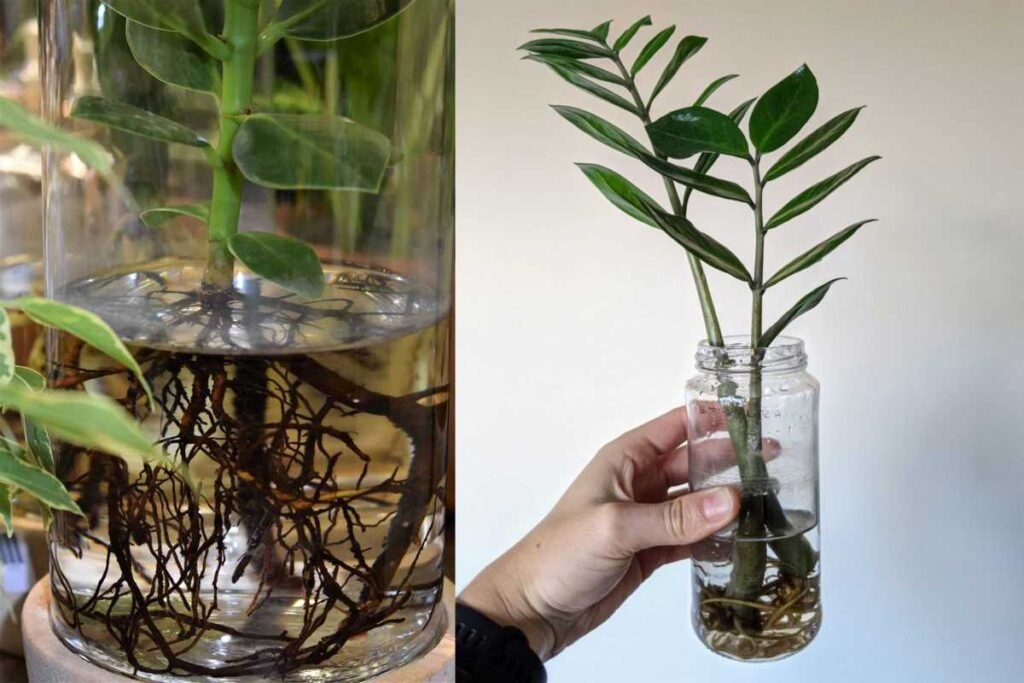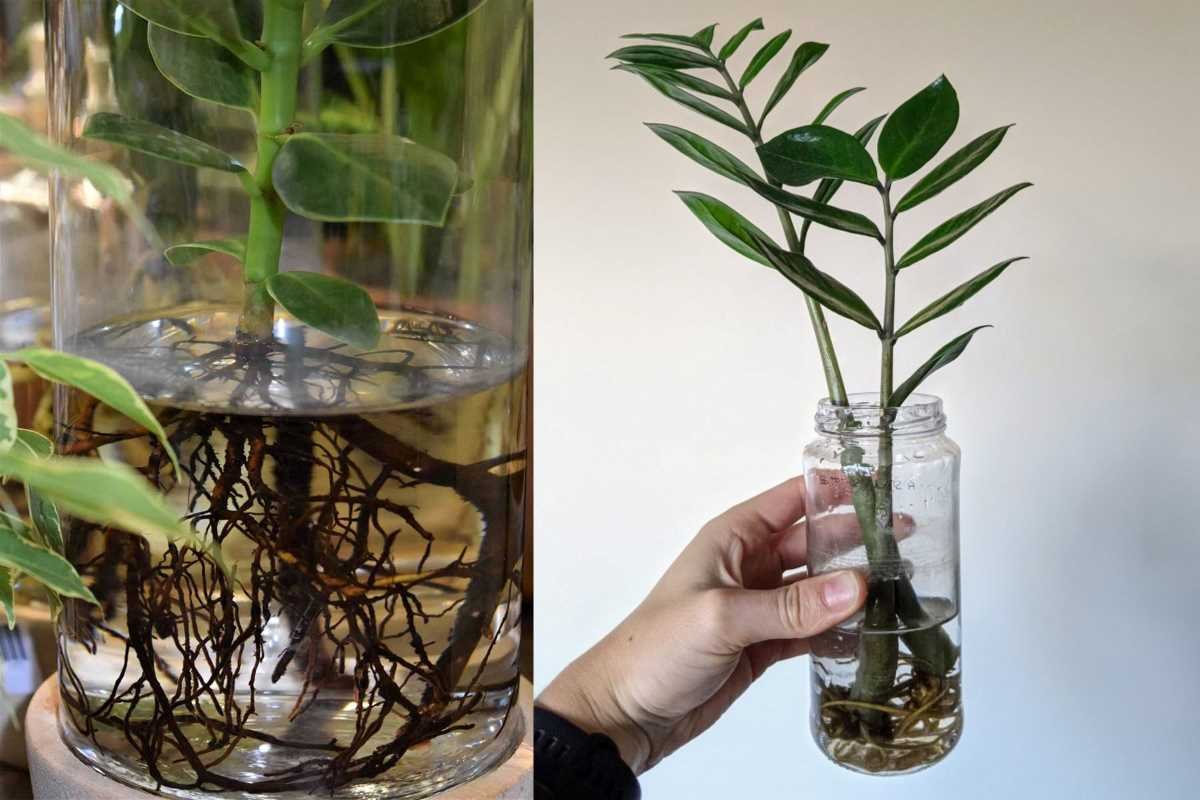Are you looking for an easy way to grow a ZZ plant? Growing a ZZ plant in water is one of the easiest and most reliable methods.
The ZZ plant (Zamioculcas zamiifolia, Zanzibar Gem) is also known as the “eternity plant” due to its ability to survive long periods of time without water.
It’s a tropical evergreen succulent that is native to Eastern Africa, making it an ideal choice for anyone who wants to bring the lushness of the jungle into their homes.
In this blog post, we will go over how to grow a ZZ plant in water.

How to Grow a ZZ Plant in Water?
Here are a few step-by-step guidelines to help you grow a ZZ plant in water successfully:
First, Select material:
You will need to select your starting material.
You will need either a mature stem cutting or some healthy roots that are at least 2 inches long. If you are using a stem cutting, make sure it has at least two sets of leaves and cut it just below a leaf node (the point where leaves grow from).
Once you have your starting material, fill up a glass jar with fresh water and drop your stem or roots into it.
Place the jar in an area that gets bright filtered light but not direct sunlight – think indirect light coming through windows or curtains – and keep its temperature steady by avoiding drafty areas.
Are any ingredients in water?
It’s important to note that there are no special ingredients or additives needed to grow a ZZ plant in water.
As long as you keep the water fresh and replace it regularly, your ZZ plant will thrive in this environment and will quickly start to grow new stems and roots.
Some people recommend using fertilizer or rooting hormones as well, but these are not strictly necessary.
Once your ZZ plant has fully established itself in water, you can transfer it to a more permanent planter if desired.
Be sure to choose a well-draining potting mix and avoid overwatering or using too much fertilizer, as these can cause problems for the plant.
Also read, Propagating ZZ Plant in Water: A Step-by-Step.
The next step is crucial:
Do not change out the water until the new growth starts appearing!
This could take anywhere from 4-6 weeks, depending on temperature and other factors like light intensity.
During this period, you should check on your jar every couple of days and make sure the water level hasn’t gone down too low – top it off with more fresh water if it has.
When new growth appears (usually small shoots), it’s time for another change out!
Empty out all the old water completely and fill your jar with fresh tap water again – then replace this new batch every two weeks for the best results.
Keep in mind
It is important to note that when grown in water, ZZ plants will never bloom; their flowers only appear when grown in the soil!
That being said, when planted in the soil they can reach heights of up to 3 feet tall which makes them really impressive houseplants.
However, if you don’t want such large plants inside your house or apartment then growing them hydroponically makes perfect sense – they’ll stay short yet still look absolutely gorgeous!
Warning:
Growing a ZZ plant in water is a fun and rewarding experience, but it does require quite a bit of attention and care.
Remember to always use clean, fresh water and follow the recommended watering schedule for the best results.
Also, if you notice any signs of root rot or other issues developing, take action right away to help your plant recover.
With the right combination of water, light, and care, your ZZ plant should thrive and look beautiful for many years to come!
Conclusion
So, how to grow ZZ plants in water? It’s quite easy – all you need to do is fill a mason jar or other glass container with fresh, clean water, place the plant into the water, and then make sure to keep it in a bright location with good-quality water and regular light.
As long as you are providing these basic conditions, your ZZ plant should thrive and grow quite nicely in water.
With a little bit of care and attention, your ZZ plant should continue to flourish and look beautiful for many years to come!
Good luck!
Related FAQs:
1. Can I use tap water for my ZZ plant?
Yes, you can use tap water for your ZZ plant, but it’s best to let the water sit out for 24 hours before using it to allow any chlorine to dissipate. Alternatively, you can use filtered or distilled water to avoid any potential chemical build-up.
2. What is the ideal temperature range for growing a ZZ plant in water?
ZZ plants thrive in temperatures between 60-75°F (16-24°C). Avoid placing your plant in drafty areas or where temperatures fluctuate significantly.
3. How can I prevent root rot in my water-grown ZZ plant?
To prevent root rot, ensure you change the water regularly (every 1-2 weeks) and use a clean container. Avoid letting the water become stagnant, and if you notice any discolored or mushy roots, trim them off immediately.
4. Can I use any container for growing my ZZ plant in water?
You can use any clear glass or plastic container that allows you to monitor the root growth and water level. Ensure the container is clean and free of any residues that could harm the plant.
5. How long can a ZZ plant live in water?
A ZZ plant can live indefinitely in water if provided with the right care, including regular water changes and sufficient light. However, it may eventually benefit from being transferred to soil for a more nutrient-rich environment.
6. Do ZZ plants need fertilizer when grown in water?
Fertilizer is not strictly necessary for ZZ plants grown in water, but you can add a diluted, water-soluble houseplant fertilizer once every few months to provide extra nutrients. Be cautious not to over-fertilize, as this can cause nutrient burn.
7. How can I propagate ZZ plants in water?
To propagate ZZ plants in water, take a healthy leaf or stem cutting with at least two leaf nodes. Place the cutting in water, ensuring the nodes are submerged. Keep it in a bright, indirect light location, and change the water regularly. Roots should begin to form in a few weeks.
8. How do I know when it’s time to transfer my ZZ plant from water to soil?
You can transfer your ZZ plant to soil once it has developed a healthy root system with multiple roots at least a few inches long. Choose a well-draining potting mix and a pot with drainage holes to prevent waterlogging.
9. What should I do if my ZZ plant’s leaves turn yellow while growing in water?
Yellow leaves can indicate several issues, such as overwatering, underwatering, or insufficient light. Ensure the water is clean and changed regularly, and place the plant in bright, indirect light. Remove any yellow leaves to prevent potential rot and monitor the plant for further signs of stress.
10. Can ZZ plants grow in low light conditions?
ZZ plants are tolerant of low light conditions, but they thrive best in bright, indirect light. If grown in low light, they may grow more slowly and produce smaller leaves. If possible, provide your ZZ plant with ample indirect sunlight to encourage robust growth.
11. Are there any specific pests to watch out for when growing ZZ plants in water?
While ZZ plants are generally pest-resistant, they can occasionally attract pests like spider mites, aphids, or mealybugs. Regularly inspect your plant for signs of pests, and if detected, treat the plant with insecticidal soap or neem oil.
12. How can I tell if my ZZ plant needs more water?
In a water-growing setup, you won’t need to water the plant directly. Instead, ensure the water level in the container stays consistent, covering the roots but not submerging the leaves. Top off the water as needed to maintain the appropriate level.
13. Can I use rainwater for my ZZ plant?
Yes, rainwater is an excellent choice for ZZ plants as it is naturally free of many chemicals found in tap water. Just make sure to collect and store the rainwater in a clean container.
14. How often should I clean the container holding my ZZ plant?
It’s a good practice to clean the container every time you change the water, which should be every 1-2 weeks. This helps prevent algae growth and keeps the environment healthy for your plant.
15. Can I grow a ZZ plant in a hydroponic system?
Yes, ZZ plants can be grown in a hydroponic system. This setup can provide a controlled environment for optimal growth. Ensure the hydroponic system has a balanced nutrient solution and proper aeration.
16. What should I do if algae start growing in the water?
If you notice algae growth, clean the container thoroughly with a mild bleach solution (1 part bleach to 9 parts water), rinse it well, and refill it with fresh water. Reduce light exposure if possible, as algae thrive in bright light.
17. Will the leaves of my ZZ plant be smaller if grown in water compared to soil?
Leaves of ZZ plants grown in water may be smaller and the plant might grow more slowly compared to those grown in soil. However, with proper care and conditions, they can still be healthy and attractive.
18. How can I tell if my ZZ plant is not getting enough nutrients in water?
Signs of nutrient deficiency include slow growth, pale or yellowing leaves, and weak stems. If you observe these symptoms, you can add a diluted liquid houseplant fertilizer to the water, following the recommended dosage.
19. Can I grow multiple ZZ plants in the same water container?
Yes, you can grow multiple ZZ plants in the same container as long as there is enough space for their roots and they are not overcrowded. Ensure all plants have adequate light and regular water changes.
20. What is the best way to trim or prune my ZZ plant grown in water?
Pruning is not often needed for ZZ plants, but you can trim any dead or yellowing leaves close to the base of the stem. Use clean, sharp scissors or pruning shears to make precise cuts and avoid damaging the plant.
21. How do I acclimate a ZZ plant from water to soil?
To acclimate a ZZ plant from water to soil, gently remove it from the water and rinse off any excess water. Plant it in a well-draining potting mix and water lightly. Gradually increase the amount of light exposure and water as needed to avoid transplant shock.
22. Can I use a decorative container without drainage holes for growing ZZ plants in water?
Yes, you can use decorative containers without drainage holes since the plant is grown in water. Ensure the container is transparent enough to monitor root health and water levels easily.
23. How can I identify and treat root rot in my ZZ plant?
Root rot is typically identified by black, mushy roots and a foul odor. To treat root rot, remove the plant from the water, trim away all affected roots with clean scissors, and place the plant in fresh water. Ensure regular water changes to prevent recurrence.
24. Is it possible to grow a ZZ plant in water indefinitely?
Yes, it is possible to grow a ZZ plant in water indefinitely as long as you provide regular care, including water changes, proper lighting, and occasional nutrient supplementation. However, for long-term growth and maximum health, transferring to soil is sometimes recommended.
25. What type of light is best for a ZZ plant grown in water?
Bright, indirect light is ideal for ZZ plants grown in water. They can tolerate lower light levels, but growth may be slower. Avoid direct sunlight, which can scorch the leaves and cause water temperature to fluctuate.
26. Do I need to use any special growing conditions?
It is generally not necessary to use any additional fertilizer or light when growing a ZZ plant in water, as long as you are providing good-quality water and a bright, but not too sunny, location.
However, if you want to give your plant an extra boost, you can try using a fertilizer specially formulated for houseplants, or you can add a small amount of organic compost to the water.
27. How often should I change out the water?
It is generally recommended to change out the water in your ZZ plant jar once every 2 weeks, or whenever it starts to look cloudy.
Remember to never water from the top, and always use fresh, clean water instead.

